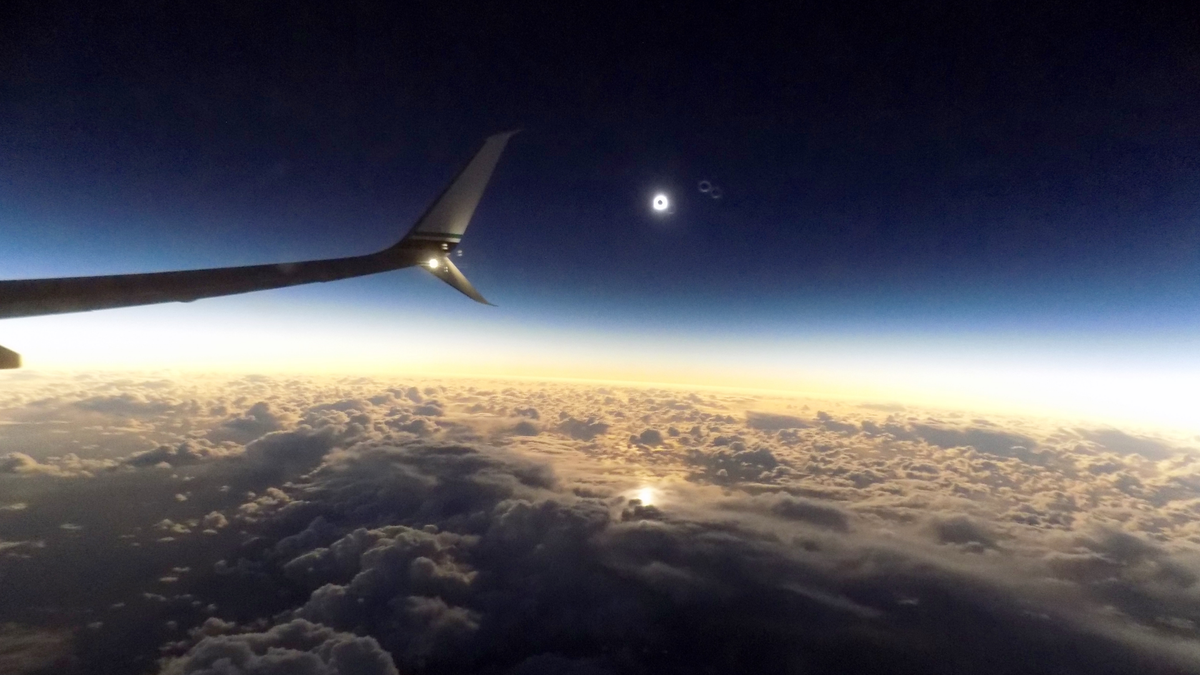
A view of the total solar eclipse of March 8, 2016, as seen by Space.com skywatching columnist Joe Rao and other passengers aboard Alaska Airlines Flight 870 from Alaska to Hawaii. The airline is also offering an eclipse-viewing flight on Aug. 21, 2017. (Joe Rao/Space.com)
NEW YORK — On a midsummer night's eve, veteran meteorologist and Space.com skywatching columnist Joe Rao led a sold-out show at the Hayden Planetarium for its "Astronomy Live: Stars of Summer" Program on Tuesday, July 25, where he turned his expertise to the upcoming total solar eclipse.
A longtime educator at the American Museum of Natural History in New York, Rao spoke enthusiastically at the adjacent Hayden Planetarium about why folks across the country should do their best to view the Aug. 21 solar eclipse, calling it "one of the events of the century."
Early in the presentation, after a video introduction, Rao led a tally of the audience, entitled, "Have you ever seen a total solar eclipse?", and comedically shut down answers of "I think so," "I'm pretty sure" and the super-casual "yeah," to prove a viewer had not in fact experienced the phenomena. It inspires more of an existential awe than a mere few words, he said. [Total Solar Eclipse 2017: When, Where and How to See It (Safely)]
2017 Solar Eclipse with Joe Rao from Michael Kozel on Vimeo.
According to Rao, viewing the rare spectacle is akin to watching a Broadway theater's lights dimming before the drama begins: The excitement kicks in as one feels the temperature change and the birds quiet down. He said that a viewer will leave feeling so engrossed in every moment of a total solar eclipse that they feel like it passes in just seconds, although it lasts a few minutes.
People in parts of Africa, South America and Europe will be able to see at least a partial eclipse in August, and about 220 million people will be within an hour's drive of the moon's dark conical shadow as it moves across the United States, Rao said. The path of totality will average about 100 miles (161 kilometers) in width, and 12 million people are already living within the "fortuitous" path of the eclipse, he said.
Rao emphasized these numbers to encourage the audience to plan for traffic during their travels leading up to and after Aug. 21. According to an old news article Rao shared during the program, people have been waiting for this eclipse since as far back as 1932. Rao advised the delighted audience to pay special attention to Interstates 5 and 85, the latter of which takes you out of Atlanta. This is a major city sitting just outside the path of totality, so he warned that its associated interstate is likely to suffer large traffic jams in the days preceding the eclipse.
For instance, he advised using welder's glass No. 13 or No. 14, which is available at most hardware stores. Another safe option is to look at tree leaves, since the sun will cast crescent-shaped shadows on foliage. Rao warned people to under no circumstances look directly at the sun . According to Rao, there are no pain sensors in the eye's retina, so someone could be burning their eyes without noticing.Whether they'll be viewing a partial or total eclipse, Rao said there will be approximately 600 million people looking skyward on Aug. 21 across the world. He described some do-it-yourself methods that guests could share with their loved ones if they did not have eclipse-viewing glasses and found themselves looking for last-minute eclipse-viewing solutions.
Having himself traveled to various solar eclipse sites throughout the years, Rao said he's "very happy to file [his] celestial reports" for all to enjoy and learn from.
REMEMBER: Looking directly at the sun, even when it is partially covered by the moon, can cause serious eye damage or blindness . NEVER look at a partial solar eclipse without proper eye protection . See our complete guide to find out how to view the eclipse safely .
Buy Eclipse Glasses by American Paper Optics on Amazon.com Buy Rainbow Symphony Eclipse Glasses on Amazon.com
Editor's note: Space.com has teamed up with Simulation Curriculum to offer this awesome Eclipse Safari app to help you enjoy your eclipse experience. The free app is available for Apple and Android , and you can view it on the web .
Follow Doris Elin Salazar on Twitter @salazar_elin . Follow us @Spacedotcom , Facebook and Google+ . Original article on Space.com .



















